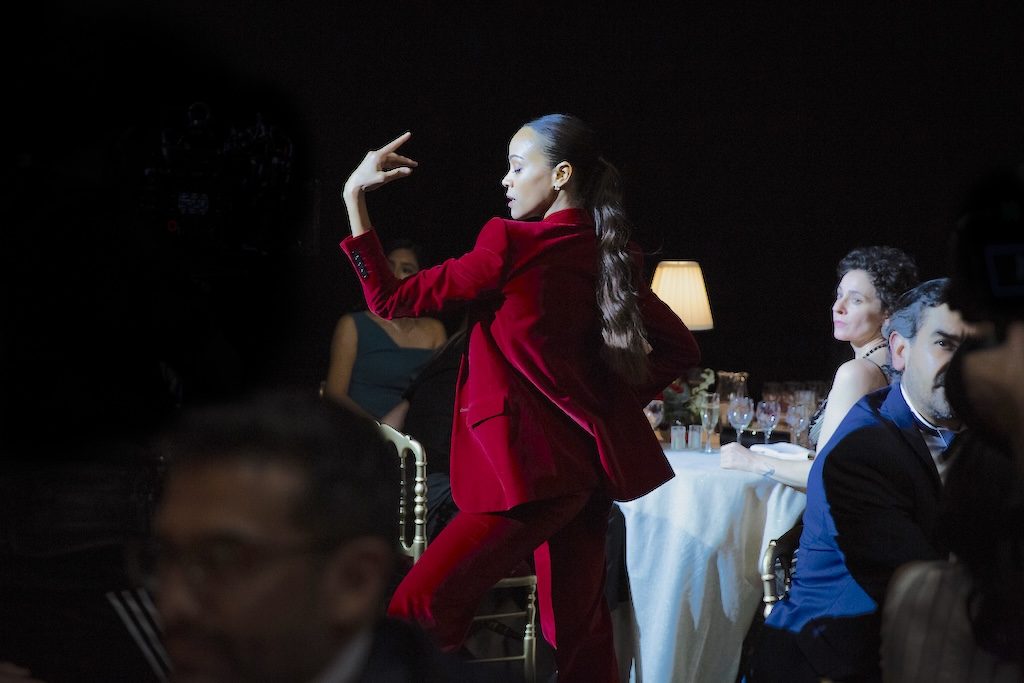Movie genre mashups are nothing new on our screens. Some common hybrids like crime thrillers or action comedies go together like hand and glove. Emilia Pérez is a bold blend of crime and musical. But that’s not the most audacious aspect of this film set among Mexico’s cartels. By some accounts, director Jacques Audiard’s (Rust and Bone) film starring Karla Sofía Gascón, Zoe Saldaña, and Selena Gomez is a genre-defying meditation on four determined women trying to live authentically in a man’s world. Women being the operative word.
Writer/ director Jacques Audiard is very much a man. The idea for Emilia began when he read a novel called Ecouté by Boris Razon about a transgender Mexican drug dealer who wanted to have surgery. Curiously, the drug dealer character wasn’t fully developed in the novel, so Audiard decided to flesh out that character as the starting point for Emilia Pérez (Karla Sofia Gascón). This sparked the female-forward transformation into his cinematic vision. Rita Moro Castro, the lawyer character played by Zoe Saldaña in the film, was originally a man in the book.
An Opera Libretto
The first draft of Emila Pérez was conceived during the first lockdown. Audiard describes this draft as being more of “an opera libretto than a film script. It was broken down into acts, there were few sets, and the characters were archetypal.” It echoes The Threepenny Opera by Bertolt Brecht and Kurt Weill. It took roughly two years to shape the screenplay into a shooting script.

Jacques Audiard. Photo by Shanna Besson
Emilia Pérez also honors its telenovela roots with lashings of “ironic comedy” and rich melodrama. The film tracks Emilia as she carries shades of courage, fear, determination, and grit over the finish line. Gender transition and affirmation is not for the faint of heart. Doing so in order to leave behind a life of crime is truly character-building.
This broad approach to genre broke the filmmaker’s creative vision wide open. “It cut across genres – film noir, melodrama, comedy of manners, musical, and telenovela,” he notes. Audiard concedes that this expansive genre cocktail may be a difficult needle to thread for some. Eventually, the genre was shortened to a “musical melodrama” or an alternative, “musical crime drama.” Audiard is still grappling with pigeon-holing his film into a genre box after its release, so we should all accept that Emilia Pérez is more about a cinematic experience than an academic genre assignment.
The Songs & Music
The film routinely breaks into choreographed song and dance – sometimes organically, sometimes abruptly. Is it a bug or a feature? A creative distraction or elevated style? Whatever audiences decide, the musical component is the film’s superpower.
Jacques Audiard never strays from his goal of a creating a big screen cinematic opera. The screenplay, song lyrics, and music were written in close co-ordination with the screenplay. Each component stimulated the other to create a unified narrative. It was never a case of adding musical interludes to disrupt the main story.

Rita Moro Castro (Zoe Saldaña. Photo by Shanna Besson
“Songs have a magic power to tell a story because they allow you to go from point A to point B faster, without any questions, because they speak to the heart,” says composer Camille.
Each character has a signature musical style that illustrates their character. Rita is viewed as “a rapper or hard-rock singer. They are a portrait of Mexico and who she is as a lawyer,” continues Camille. “She’s telling us about her state of mind.” In contrast, Emilia’s songs are “more lyrical, but very intimate.” Jessi’s (Selena Gomez) songs are “rebellious and imaginative” and Epifania’s (Adriana Paz) songs contain more “folk aspects.”
The songs evolve alongside the character arcs, sometimes moving from tender to angry, hopeful to aggressive.
Emilia is a woman who travels a long way from home to find her happy place. Gascón views her character as “a bit as of Beauty and the Beast locked in the same body. When the film opens, she is Manitas, a man who’s confined in a body she doesn’t belong in.” Then the opportunity presents itself for her to shed her cocoon and blossom into a butterfly. Emilia Pérez is a story of rebirth, truth, and manifestation. But it isn’t all smooth sailing – or transitioning.
On one hand Manitas discards the societal male privilege society affords men, and on the other hand, Emilia navigates the restrictions and expectations society has on women.
There’s nothing stronger sometimes than a band of women coming together as a collective, as a united front, as one voice, to create harmony, magic, and art – Zoe Saldaña
The relationship between Manitas/ Emilia and Rita is fraught with thorny challenges. Both are disheartened with their lives and seek a major directional change in pursuit of authenticity. So, Manitas hires Rita to fake his death and find a suitable clinic to transform her into Emilia leading into a powerful adventure.
